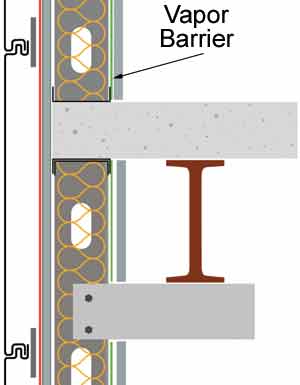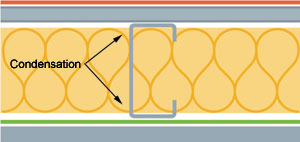Thermal and Moisture Control in Exterior Metal Walls
Achieving durable, economical, and sustainable metal wall systems
This course is no longer active
Advertorial course provided by CENTRIA
Moisture Control Designs for Cold
to Very Cold Climates
Key elements for controlling moisture in a typical multi-component
wall assembly for cold climates (Figure 3) are:
- The vapor barrier−retarder: Airflow and vapor move from warm high pressure to cold lower pressures. In northern regions, winter is the critical time, when outside temperatures will average 8 degrees Fahrenheit, with a 20 percent RH and the interior ambient is 70 degrees Fahrenheit, with a 40 percent RH. Given these conditions, the dew point of the wall is 45 degrees Fahrenheit. If the vapor barrier-retarder were ineffective, vapors that enter the wall cavity would condense at a rate of as high as three pints of water per 100 square feet of wall area per week.
|
- Air and water barriers: An ineffective air barrier causing
air leakage is considerably worse, because 80 pints of water
could condense in the same one-week time frame. The comparison
depicts how critical the air barrier is for moisture control.
Using the previous temperatures, consider the temperatures of the metal studs (Figure 4). These range from 17.5 degrees Fahrenheit on the exterior side to 37 degrees Fahrenheit on theinterior. This is significant, indicating a problem with either the air or vapor barriers entering the cavity. Any surface that is below the dew point of 45 degrees Fahrenheit and in contact with the moisture laden air will cause condensation. Condensation in the cavity will cause corrosion of the stud and reduction in the thermal value of fiberglass insulation (Figure 4).
|
Originally published in Architectural Record.
Originally published in January 2006











